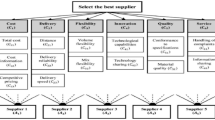Abstract
In this paper we extend the additive multi-attribute utility model to incorporate the concept of veto in a group decision-making context. Moreover, trapezoidal fuzzy numbers are used to represent the relative importance of criteria for each DM, and uncertainty about the alternative performances is considered by means of intervals. Although all DMs are allowed to provide veto values, the corresponding vetoes are effective for only the most important DMs. They are used to define veto ranges. Veto values corresponding to the other less important DMs are partially taken into account, leading to the construction of adjust ranges. Veto and an adjust function are then incorporated into the additive model, and a fuzzy dominance matrix is computed. A dominance measuring method is then used to derive a ranking of alternatives for each DM, which are then aggregated to account for the relative importance of DMs.
Access this chapter
Tax calculation will be finalised at checkout
Purchases are for personal use only
Similar content being viewed by others
References
Arrow, K.J., Raynaud, H.: Social Choice and Multicriterion Decision Making. MIT Press, Cambridge (1986)
Moulin, H.: The proportional veto principle. Rev. Econ. Stud. 48, 407–416 (1981)
Roy, B., Slowinski, R.: Handling effects of reinforced preference and counter-veto in credibility of outranking. Eur. J. Oper. Res. 188, 185–190 (2008)
Nowak, M.: Preference and veto threshold in multicriteria analysis based on stochastic dominance. Eur. J. Oper. Res. 158, 339–350 (2004)
Munda, G.: A conflict analysis approach for illuminating distributional issues in sustainability. Eur. J. Oper. Res. 194, 307–322 (2009)
Bana e Costa, C.A., Corra, E., De Corte, J.M., Vansnick, J.C.: Faciliting bid evalutation in public call for tenders: a social-technical approach. Omega 30, 227–242 (2002)
Marichal, J.L.: Tolerant or intolerant character of interacting criteria in aggregation by the choquet integral. Eur. J. Oper. Res. 155, 771–791 (2004)
Liginlala, D., Ow, T.T.: Modeling attitude to risk in human decision processes: an application of fuzzy measures. Fuzzy Sets Syst. 157, 3040–3054 (2006)
Daher, S.S.D., de Almeida, A.T.: The use of ranking veto concept to mitigate the compensatory effects of additive aggregation in group decisions on a water utility automation investment. Group Decis. Negot. 21, 185–204 (2012)
Raiffa, H.: The Art and Science of Negotiation. Harvard University Press, Cambridge (1982)
Stewart, T.: Robustness of additive value function method in MCDM. J. Multicriteria Decis. Anal. 5, 301–309 (1996)
Yue, Z.: A method for group decision-making based on determining weights of decision makers using TOPSIS. Appl. Math. Model. 35, 1926–1936 (2011)
Yoon, K.: System selection by multiple attribute decision making. PhD thesis. Kansas State University Press, Manhattan (1980)
Hwang, C.L., Yoon, K.: Multiple Attribute Decision-making: Methods and Applications. Springer, Berlin (1981)
Dokas, I.M., Nordlander, T.E., Wallace, R.J.: Fuzzy fault tree representation and maintenance based on frames and constraint technologies: a case study. In: Workshop on Knowledge Capture and Constraint Programming. Whistler, British Columbia, Canada (2007)
Vicente, E., Mateos, A., Jiménez-Martín, A.: Risk analysis in information systems: a fuzzification of the MAGERIT methodology. Knowl.-Based Syst. 66, 1–12 (2014)
Vicente, E., Jiménez, A., Mateos, A.: An interactive method of fuzzy probability elicitation in risk analysis. In: Intelligent Systems and Decision Making for Risk Analysis and Crisis Response, pp. 223–228. CRC Press, New York (2013)
Jiménez, A., Mateos, A., Sabio, P.: Dominance intensity measure within Fuzzy weight oriented MAUT: an application. Omega 41, 397–405 (2013)
Aguayo, E., Mateos, A., Jiménez-Martín, A.: A new dominance intensity method to deal with ordinal information about a DM’s preferences within MAVT. Knowl.-Based Syst. 69, 159–169 (2014)
Mateos, A., Jiménez-Martín, A., Aguayo, E., Sabio, P.: Dominance intensity measuring methods in MCDM with ordinal relations regarding weights. Knowl.-Based Syst. 70, 26–32 (2014)
Tran, L., Duckstein, L.: Comparison of fuzzy numbers using a Fuzzy number measure. Fuzzy Sets Syst. 130, 331–341 (2002)
Lin, S.: Rank aggregation methods. WIREs Comput. Stat. 2, 555–570 (2010)
Green, P.: Research for Marketing Decisions. Prentice-Hall, New Jersey (1978)
Borda, J.: Memoire Sur les Elections au Scrutin. Histoire de l’Academie des Sciences, Paris (1981)
DeConde, R., Hawley, S., Falcon, S., Clegg, N., Knudsen, B., Etzioni, R.: Combining results of microarray experiments: a rank aggregation approach. Stat. Appl. Genet. Mol. Biol. 5, 5–15 (2006)
Kemeny, J.: Mathematics without numbers. Daedalus 88, 577–591 (1959)
Lin, S., Ding, J.: Integration of ranked lists via cross entropy monte carlo with applications to mRNA and microRNA studies. Biometrics 65, 9–18 (2009)
Author information
Authors and Affiliations
Corresponding author
Editor information
Editors and Affiliations
Rights and permissions
Copyright information
© 2015 Springer International Publishing Switzerland
About this paper
Cite this paper
Sabio, P., Jiménez-Martín, A., Mateos, A. (2015). Veto Values Within MAUT for Group Decision Making on the basis of Dominance Measuring Methods with Fuzzy Weights. In: Kamiński, B., Kersten, G., Szapiro, T. (eds) Outlooks and Insights on Group Decision and Negotiation. GDN 2015. Lecture Notes in Business Information Processing, vol 218. Springer, Cham. https://doi.org/10.1007/978-3-319-19515-5_10
Download citation
DOI: https://doi.org/10.1007/978-3-319-19515-5_10
Published:
Publisher Name: Springer, Cham
Print ISBN: 978-3-319-19514-8
Online ISBN: 978-3-319-19515-5
eBook Packages: Computer ScienceComputer Science (R0)




